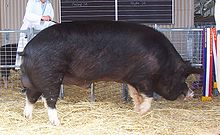Berkshire pig
 Berkshire boar at the 2005 Royal Adelaide Show | |
| Conservation status | |
|---|---|
| Country of origin | United Kingdom |
| Distribution | world-wide |
| Use | Meat |
| Traits | |
| Weight | |
| Skin colour | black |
| Hair | black |
| |
The Berkshire is a British breed of pig. It originated in the English county of Berkshire, for which it is named. It is normally black, with some white on the snout, on the lower legs, and on the tip of the tail.
It is a rare breed in the United Kingdom. It has been exported to a number of countries including Australia, Japan, New Zealand and the United States, and is numerous in some of them.
History[]
The Berkshire is thought to have originated in Reading, the county seat of Berkshire. It is one of the oldest breeds of pigs in England. It was the first breed to record pedigrees in herd books.[5] Herds of the breed are still maintained in England by the Rare Breeds Survival Trust at Aldenham Country Park, Hertfordshire, and by the South of England Rare Breeds Centre in Kent. The Berkshire was listed as vulnerable in 2008; fewer than 300 breeding sows were known to exist at that time, but with the revived popularity of the breed through its connection to the Japanese marketing of a "wagyu for pork" connection, the numbers have increased.[6]
Until the eighteenth century the Berkshire was a large tawny-coloured pig with lop ears, often with darker patches.[7]: 551 [5] In the late eighteenth and early nineteenth centuries it was substantially modified by cross-breeding with small black pigs imported from Asia.[7]: 558
Characteristics[]
The Berkshire is of medium size: adult boars weigh about 280 kilograms (600 lb), sows about 220 kilograms (500 lb).[4] It is black with six white markings: four white socks, a white splash on the snout, and a white tip to the tail.[8] It is prick-eared.[8]
Berkshire pork, prized for juiciness, flavour, and tenderness, is pink-hued and heavily marbled. Its high fat content makes it suitable for long cooking and high-temperature cooking.[9] The meat also has a slightly higher pH, according to food science professor Kenneth Prusa of Iowa State University. Increased pH makes the meat darker, firmer, and more flavourful. High pH is a greater determinant than fat content in the meat's overall flavour characteristics.[10]
In other countries[]
Japan[]
The Berkshire was first exported to Japan in the 1860s, and has become numerous there: in 2007 there were over 330,000. The Japanese Kagoshima Berkshire, which apparently derives from two British Berkshire pigs imported to Japan in the 1930s, is considered a separate breed;[7]: 629 the meat may be marketed as Kurobuta pork, and command a premium price.
United States[]
In the United States, the American Berkshire Association, established in 1875, gives pedigrees only to pigs directly imported from established English herds or to those tracing directly back to such imported animals.[9] The association was the first Swine Registry to be established and the first hog recorded was "Ace of Spades", a boar bred by Queen Victoria.[11]
References[]
- ^ Barbara Rischkowsky, Dafydd Pilling (editors) (2007). List of breeds documented in the Global Databank for Animal Genetic Resources, annex to The State of the World's Animal Genetic Resources for Food and Agriculture. Rome: Commission on Genetic Resources for Food and Agriculture, Food and Agriculture Organization of the United Nations. ISBN 9789251057629. Archived 23 June 2020.
- ^ RBST Watchlist 2011. Kenilworth, Warwickshire: Rare Breeds Survival Trust. Archived 2 December 2011.
- ^ Pigs watchlist. Kenilworth, Warwickshire: Rare Breeds Survival Trust. Archived 18 December 2020.
- ^ a b c Berkshire. Kenilworth, Warwickshire: Rare Breeds Survival Trust. Archived 23 September 2020.
- ^ a b Berkshire - New Zealand Pig Breeders Association website
- ^ Rare Breeds Survival Trust watch list. Rare Breeds Survival Trust. Archived 31 July 2008
- ^ a b c Valerie Porter, Lawrence Alderson, Stephen J.G. Hall, D. Phillip Sponenberg (2016). Mason's World Encyclopedia of Livestock Breeds and Breeding (sixth edition). Wallingford: CABI. ISBN 9781780647944.
- ^ a b The Berkshire. The British Pig Association. Archived 12 June 2006.
- ^ a b Zeldes, Leah A. (27 January 2010). "Eat this! Berkshire pork, a meaty heritage". Dining Chicago. Chicago's Restaurant & Entertainment Guide, Inc. Archived from the original on 1 February 2010. Retrieved 27 January 2010.
- ^ Premium (High-End) Pork Cooks Illustrated, July 2011
- ^ "History – American Berkshire Association". Retrieved 28 May 2019.
External links[]
| Wikimedia Commons has media related to Berkshire pig. |
- Pig breeds
- History of Berkshire
- Pig breeds originating in England
- Animal breeds on the RBST Watchlist



